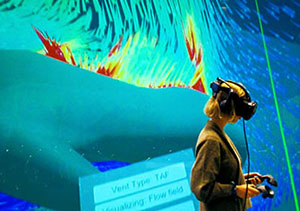Bacteria in the air visualised in hospitals
Technology can reduce the airborne spread of infection

KTH researchers are now using virtual reality (VR) to visualise bacteria in the air.
“We visualise particle movement in indoor air and pollutants in operating rooms via so-called supercomputer simulation,” says Parastoo Sadeghian, a member of the VisBac project at KTH.
According to the Swedish Board of Health and Welfare, over 1,500 patients in Sweden die every year as a consequence of serious infections that they have contracted in hospital.
Fully 98 percent of bacteria in surgical wounds have been proven to come from the surrounding air.
“We have been able to visualise how airborne bacteria spread in hospital operating rooms as a consequence of the way medical personnel work and how big an impact this has,” says Sadeghian.

Researchers have visualised the movements of bacteria in the air with a virtual and augmented reality (AR) interface that translates complicated simulation data into easy to understand animations.
By wearing a VR headset, doctors and other healthcare personnel can gain a better picture of what is happening in the air during the course of a surgical procedure.
The flow of bacteria in the air are affected by several factors – such as by the ventilation system, size of the bacteria-carrying particles, the heating system in the room, the activities of the surgical team, placement of operating equipment, and by the heat generated by the equipment.
Bacteria remain in the air for hours
The thinking behind the VisBac project is, to afford healthcare personnel an opportunity to learn more about how airborne bacteria spread. In doing so, they can adapt the way they work during operations to minimise the risk of infection.

“In addition the interface clearly shows how air that has been contaminated by bacteria can be spread by the surgical staff moving round the room. It also shows how the risk of bacteria spreading increases when healthcare personnel for example lean over the patient on the operating table,” Sadeghian explains.

Bacteria that cause serious surgical infections can remain in indoor air for a long time, encapsulated in microscopic drops.
Do we know how long bacteria-carrying particles can remain in a room?
“Bacteria can remain in the air for several hours. The time aspect depends on many factors, and this is one of the questions we hope our research will be able to answer,” says Sadeghian.

VisBac project research leader, Christophe Duwig, adds:
“The increase in bacterial resistance to antibiotics in recent years means the use of this kind of technology will be especially important moving forward. Resistant bacteria are seen as a global threat, and in the future, even simple surgical interventions can become life threatening unless we can get to grips with these problems.”
Katarina Ahlfort
Photo: VisBac

